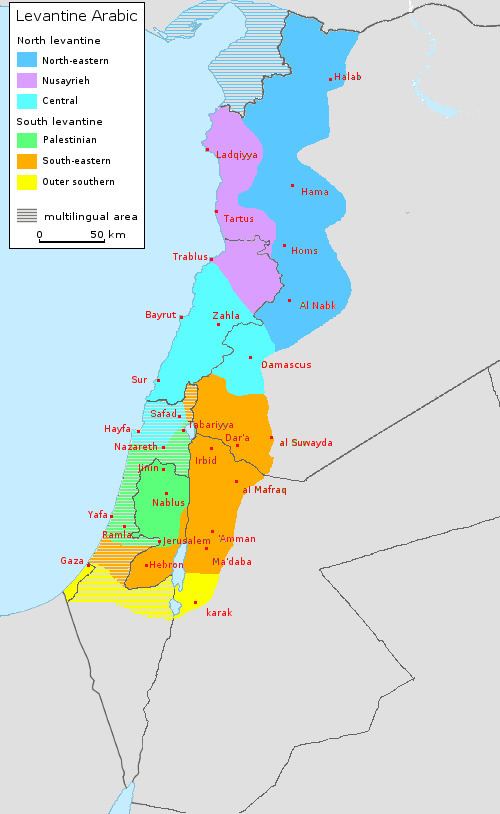Glottolog None | ||
 | ||
Language family Afro-AsiaticSemiticCentral SemiticSouth-Central SemiticArabicLevantine ArabicNorth Levantine ArabicLebanese Arabic | ||
Lebanese Arabic or Lebanese is a variety of Levantine Arabic, indigenous to and spoken primarily in Lebanon, with significant linguistic influences borrowed from other Middle Eastern and European languages, and is in some ways unique from other varieties of Arabic. Due to multilingualism among Lebanese people (the vast majority of the Lebanese people are trilingual - Lebanese Arabic, French, English), it is not uncommon for Lebanese people to mix Lebanese Arabic, French, and English languages into their daily speech.
Contents
Differences from Standard Arabic
Lebanese Arabic shares many features with other modern varieties of Arabic. Lebanese Arabic, like many other spoken Levantine Arabic varieties, has a syllable structure very different from that of Modern Standard Arabic. While Standard Arabic can have only one consonant at the beginning of a syllable, after which a vowel must follow, Lebanese Arabic commonly has two consonants in the onset.
[1]
Examples
Consonants
Comparison
This table shows the correspondence between general Lebanese Arabic vowel phonemes and their counterpart realizations in Modern Standard Arabic (MSA) and other Levantine Arabic varieties.
^1 After back consonants this is pronounced [ʌ] in Lebanese Arabic, Central and Northern Levantine varieties, and as [ɑ] in Southern Levantine varieties
Regional Lebanese Arabic dialects
Although there is a common Lebanese Arabic dialect mutually understood by Lebanese people, there are regionally distinct variations with, at times, unique pronunciation, grammar, and vocabulary.
Widely used regional dialects include:
Writing system
Lebanese Arabic is rarely written, except in novels where a dialect is implied or in some types of poetry that do not use classical Arabic at all. Lebanese Arabic is also utilized in many Lebanese songs, theatrical pieces, local television and radio productions, and very prominently in zajal.
Formal publications in Lebanon, such as newspapers, are typically written in Modern Standard Arabic, French, or English.
While Arabic script is usually employed, informal usage such as online chat may mix and match Latin letter transliterations. The Lebanese poet Saïd Akl proposed the use of the Latin alphabet but did not gain wide acceptance. Whereas some works, such as Romeo and Juliet and Plato's Dialogues have been transliterated using such systems, they have not gained widespread acceptance. Yet, now, most Arabic web users, when short of an Arabic keyboard, transliterate the Lebanese Arabic words in the Latin alphabet in a pattern similar to the Said Akl alphabet, the only difference being the use of digits to render the Arabic letters with no obvious equivalent in the Latin alphabet.
There is still today no generally accepted agreement on how to use the Latin alphabet to transliterate Lebanese Arabic words.
In 2010, The Lebanese Language Institute has released a Lebanese Arabic keyboard layout and made it easier to write Lebanese Arabic in a Latin script, using unicode-compatible symbols to substitute for missing sounds.
Said Akl's orthography
Lebanese Arabic verbs
Lebanese Arabic verbs, even though they share root similarities with many Arabic varieties, have characteristics that set them apart from verbs in other Arabic varieties.
